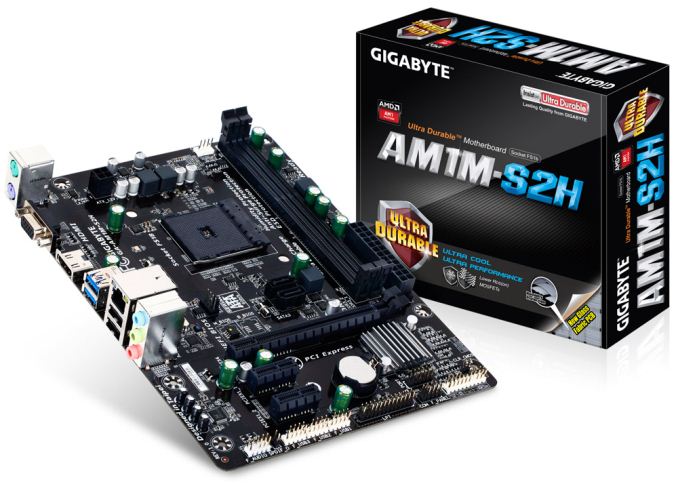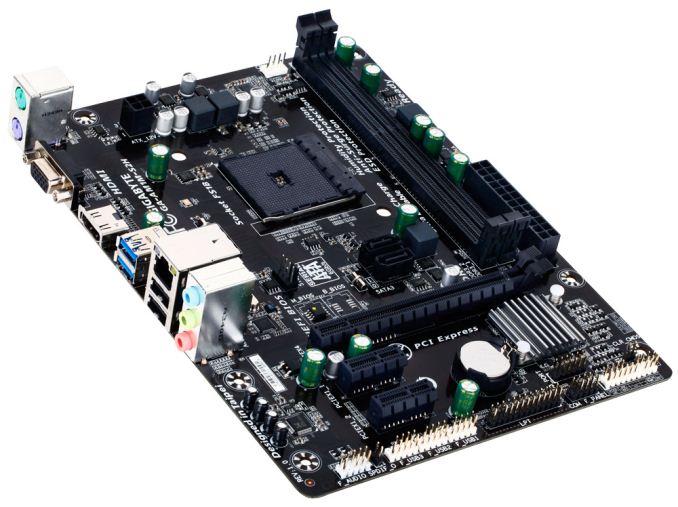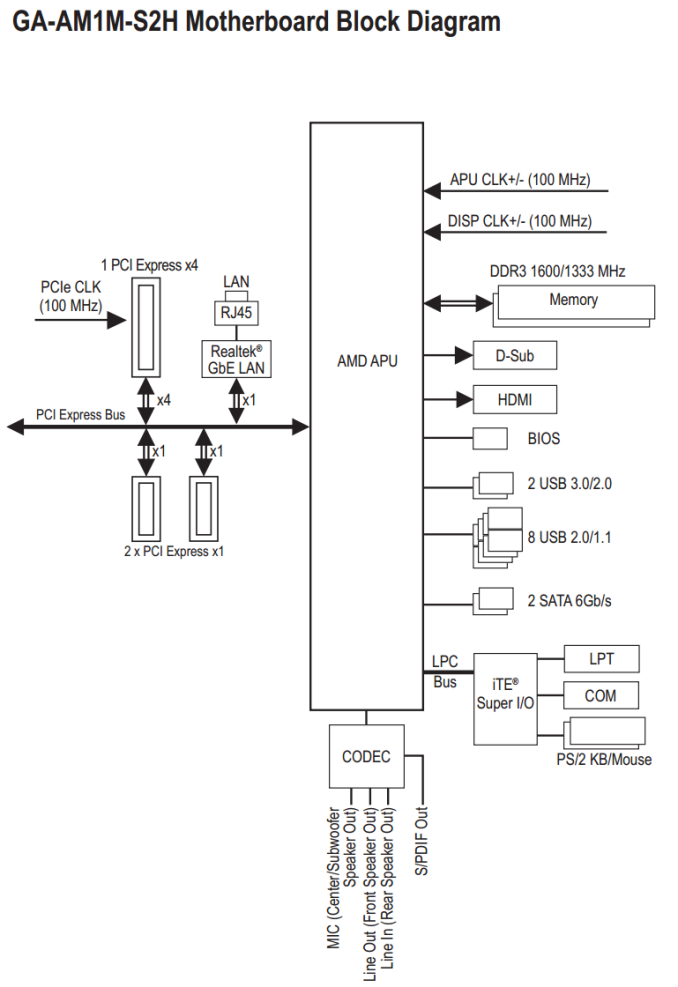GIGABYTE AM1M-S2H Review: What Can $35 Get You?
by Ian Cutress on August 15, 2014 3:00 PM EST- Posted in
- Motherboards
- AMD
- Gigabyte
- Kabini
- AM1

While most of the time enthusiasts are playing around with the latest and greatest, the cheaper low performance platforms are usually the high volume movers. As we explained in our Kabini review, AMD has taken the unusual step of producing an upgradable platform for as little as $74. The motherboards for the AM1 Kabini platform range from $31 to $47, and today we are reviewing the GIGABYTE AM1M-S2H which retails at $35.
GIGABYTE AM1M-S2H Overview
Perhaps it is just me, but a motherboard for $35 seems almost unreal. If we consider any markup by the retailer, the per-IC margins must be very minimal indeed, unless the manufacturers were selling everything at cost in order to get an idea off the ground. The AM1 range varies from $31 to $47, or $59 if you consider the one motherboard that supports a 19-volt DC-In, but they are all in either the mini-ITX or micro-ATX form factor.
The GIGABYTE AM1M-S2H falls near the bottom of that price range, although it is the larger microATX size with full-sized DDR3 support. There is no overclocking possible on this motherboard, and as such the power delivery and lack of a power delivery heatsink is suited for the low powered Kabini APUs at stock speeds. For connectivity the motherboard has three USB 2.0 headers, two SATA 6 Gbps ports, two fan headers, two USB 3.0 ports, an LPT header, a COM header, a 2.1 audio codec, gigabit Ethernet, a PCIe 2.0 x4 slot and two PCIe 2.0 x1 slots. Perhaps surprisingly, due to the low cost nature of the product, we do get GIGABYTE’s Dual BIOS here despite the increased cost to the manufacturer. When I have previously met with GIGABYTE, the product managers in the motherboard business unit insisted that Dual BIOS is a great feature no matter the price of the motherboard; as an enthusiast, I would agree.
The AM1M-S2H formed the backbone of our Kabini review, which it performed without incident. The full length PCIe slot affords use of a full sized graphics card and perhaps unsurprisingly the Athlon 5350 we used for testing still gave frame rates above 30 FPS with our standard gaming benchmarks and setups. Performance of the motherboard on the system side of things gave a DPC Latency and Audio results similar to what we would expect with a low powered platform/ALC887 audio codec, similarly with boot times. USB speeds are slightly slower than the mainstream platforms, but still within a few percentage points.
The whole focus of Kabini is for the system to be upgradable. AMD has aimed the platform for low powered use (digital signage, library computers) similar to Intel’s Atom but aim to offer faster DRAM support, upgradability and price competitiveness. The AM1M-S2H certainly hits on that last point, although the depth of the system will rely on whether AMD will refresh the Beema line for the same socket.
Visual Inspection
The AM1 platform uses the FS1b socket, which unlike the AM3+ or FM2 sockets is a nice square shape which allows for a better orientation of CPU coolers and brackets. The socket only uses two holes for push-pin connectors, and in our testing the CPU cooler that comes with the APU in the box works fine at stock speeds. There are very few aftermarket FS1b CPU coolers to choose from, although the distance to any other features on the motherboard should not make this much of an issue.
The 4-pin ATX power connector is well away from the socket, meaning that cables need not be stretched over the motherboard for attachment – such is the benefit of mATX over some mini-ITX designs. The two-phase power delivery has no heatsink, and the two CPU fan headers are at opposite corners of the socket. The 4-pin CPU fan header in white is to the top right of the socket and the 4-pin SYS header is to the bottom left, above the PCIe slots. Near this latter fan header are the two BIOS chips for GIGABYTE’s dual BIOS which makes an appearance here despite the added cost for the manufacturer.
To the bottom right of the socket is the two SATA 6 Gbps ports. Being right in the middle of the motherboard is a rather odd place for SATA ports. I understand that cheaper products have the connectors coming out of the motherboard, but having them here is a little silly. It means that any user who wants to have a SATA device (which will be anyone not booting from USB) will have to place the cable over half the motherboard to reach – not a good design plan.
The DRAM slots use a double sided latch mechanism and hide no extra controllers around the perimeter. Because the Kabini platform uses an on-die Fusion Controller Hub for IO, the heatsink in the bottom right is for the SuperIO IC dealing with extra connectivity or any PCIe lane management. For this price there are no power/reset buttons, nor a two-digit debug display, but we do get a COM header and an LPT header as well.
This motherboard does have three USB 2.0 headers at the bottom, which is perhaps a little odd but allows system manufacturers to design cases around the IO depending on the request of their clients. Next to these is the audio side of the motherboard which uses a Realtek ALC887 2.1-channel codec – users needing the ALC892/898 will have to look for a more expensive motherboard.
The rear panel contains separate PS/2 connectors for a mouse and keyboard, a D-Sub video output, HDMI, two USB 3.0 ports, two USB 2.0 ports, a Realtek network interface and audio jacks. Given the use case for this platform, perhaps a ClearCMOS button would have not been warranted, even though I like to see them on home systems.
Board Features
| GIGABYTE AM1M-S2H | |
| Price | US (Newegg) |
| Size | mATX |
| CPU Interface | Socket FS1b |
| Chipset | AMD AM1 |
| Memory Slots |
Two DDR3 DIMM slots supporting up to 32 GB Single Channel, 1333-1600 MHz |
| Video Outputs |
VGA HDMI |
| Onboard LAN | Realtek |
| Onboard Audio | Realtek ALC887 |
| Expansion Slots |
1 x PCIe 2.0 x4 2 x PCIe 2.0 x1 |
| Onboard SATA/RAID | 2 x SATA 6 Gbps |
| USB 3.0 | 2 x USB 3.0 (Back Panel) |
| Onboard |
2 x SATA 6 Gbps 3 x USB 2.0 Headers 1 x LPT Header 1 x COM Header Front Panel Audio Front Panel Header 2 x Fan Headers |
| Power Connectors |
1 x 24-pin ATX 1 x 4-pin CPU |
| Fan Headers |
1 x CPU (4-pin) 1 x SYS (4-pin) |
| IO Panel |
1 x PS/2 Keyboard Port 1 x PS/2 Mouse Port D-Sub HDMI 2 x USB 3.0 2 X USB 2.0 1 x Realtek NIC Audio Jacks (ALC887) |
| Warranty Period | 3 Years |
| Product Page | Link |
If Kabini is all about low-cost, then it makes sense when manufacturers like GIGABYTE take advantage of deals like Realtek’s audio + network combination. Perhaps $35 for a motherboard is too low to see a USB 3.0 header, although that would either require moving the USB 3.0 ports from the rear panel or adding a controller, which would have a noticeable cost.














45 Comments
View All Comments
Flunk - Friday, August 15, 2014 - link
I'm confused as to why this needs an ATX 4-pin connector at all, they were introduced to provide more power to power-hungry CPUs. This doesn't need much power on the CPU socket so it seems unnecessary.It would also have been nice to see the gaming results with the IGP, most of these boards are going to be utilized with the IGP.
Considering the price of this platform the performance seems really great, I think I would recommend something like this to people who just want a very basic desktop system.
TerdFerguson - Friday, August 15, 2014 - link
This looks great, although I insist that the possibility of a $35 functional motherboard is far less astonishing than the possibility of a $200+ motherboard. Yet again, I challenge any honest, authoritative source to break down the build cost of a "high end" motherboard.StrangerGuy - Friday, August 15, 2014 - link
Every industry tries to rip people off as much as they could get away with it...Why would mobos be any different? Most people don't need more than a $50 even for gaming purposes, let alone $100+.Lonyo - Saturday, August 16, 2014 - link
The cost of a product is more than just the bill of materials.kmmatney - Friday, August 15, 2014 - link
Maybe it cheaper to give the cpu it's own power, than routing it from the main connector? I'm sure every decision on this motherboard had cost in mind.DanNeely - Friday, August 15, 2014 - link
Probably to feed the GPU slot if someone puts a card with a decent power draw. The 24pin connector dates back to when 3.3/5V were used to power most of the mobo and only has 2 12V wires.MikeMurphy - Sunday, August 17, 2014 - link
Because when you plug in a 75w PCIe card you need all the power you can get.You make good points on the 770 but I think the point was to show which apps are CPU limited. The 5350 IGP is already well documented.
wrkingclass_hero - Friday, August 15, 2014 - link
0.0 dat power supply...Daniel Egger - Friday, August 15, 2014 - link
The selection of comparison points is rather strange, why compare power consumption of completely different aimed Intel systems (Servers, Top End of Halswells and an Atom?) rather than a Haswell Celeron or low end i3 while the benchmarks have a completely different and partially also much larger set of systems.ozzuneoj86 - Friday, August 15, 2014 - link
It seems like this happens a lot, and there are usually reasons for it, such as a lack of hardware to test on or time constraints, but if the results don't really tell us anything in the end, it is a bit frustrating. I think I said this the last time we had a Kabini review. Basically, the results often only show us that the CPU is slower than far more expensive systems, and that the AM1 CPUs increase slightly in performance as the price goes up... exactly as you'd expect. We get very little in the way of comparison between competing products, or even between old and new products. I really hope Anandtech will start supplying the reviewers with some more low end platforms if we're going to keep getting reviews like this. I just feel kind of bad for the writers of these nice reviews when the readers walk away from a review in the end not really having any more information about how the product compares to similarly priced options, slightly more expensive options, or older options that they might be able to get cheaper. They can only run tests with hardware that is available to them... and clearly there's a lack of entry-level hardware available to the guys here. I'm sure someone would be willing to donate some stuff to make these reviews more helpful. We need some comparisons with ivy and sandy bridge celeron (847, 1037u), older APUs (E350, A4 3xxx), Haswell celeron (G1830), older Athlons (X2, II X2, X2 e low power chips), Core 2 (E4300, E8400) and 771 Xeons (like the L5240, L5420, since they can be had for cheap now and modded to 775). These are the options I think of when I think of systems like Kabini, and they are for the most part nowhere to be seen in these reviews.